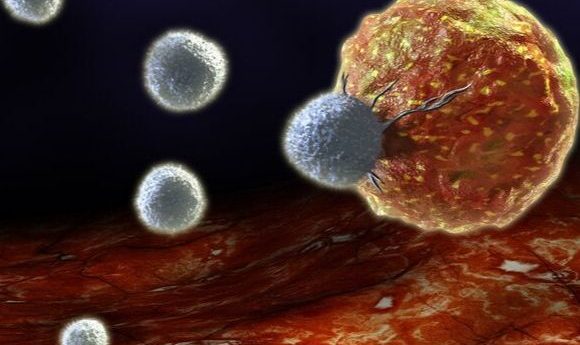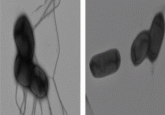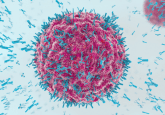Taming the body’s natural killer cells

Researchers have discovered a way to control natural killer (NK) cells, a finding that could be exploited in the development of future cancer treatments.
NK cells are a vital arm of the innate immune system, they recognize virally infected cells or cancer cells and respond by inducing cell death via apoptosis, as well as mediating the immune response via the release of cytokines.
Healthy cells express major histocompatibility complex class I receptors on their surface, which inhibit NK cells from inducing apoptosis. Cancer cells and other infected cells lose these receptors, meaning NK cells recognize them as foreign.
NK cells have two mechanisms for stimulating apoptosis in foreign cells. In one method, the release of cytotoxic granules – such as perforin – create pores in the target cell membrane, through which additional toxins enter and stimulate apoptosis. Alternatively, NK cells induce apoptosis via the so-called death ligands, special proteins that are located on their cell membranes. The death ligands of NK cells dock to corresponding receptors found on target cells and activate the apoptotic process.
Now, a group of researchers, led by Philippe Krebs of the University of Bern (Switzerland), have investigated one death ligand: tumor necrosis factor-related apoptosis-inducing ligand (TRAIL). Tumor cells are understood to be more sensitive to the effects of TRAIL then healthy cells, meaning TRAIL has the potential to be utilized to treat cancer cells without harming the surrounding tissue.
By characterizing the role of TRAIL in viral infections, the group identified a mechanism by which the killer cells can be controlled in order to attune the immune response.
- Microvesicles could revolutionize cancer therapeutics
- High-dose, high reward? New potential treatment for prostate cancer
- Boosting natural killer cells could help fight cancer
The group utilized TRAIL-knockout mice that were infected with lymphocytic choriomeningitis virus. It was discovered that these mice were better able to respond to infection than control animals. Deletion experiments demonstrated that NK cells in TRAIL-lacking mice secreted more cytokines and had improved specific CD8+ T‐cell responses, resulting in an improved ability to kill virus-infected cells.
Removing TRAIL resulted in the “taming” of the NK cells. They could not readily induce apoptosis, so were more sensitive to molecules causing them to produce more cytokines – such as IFNγ – leading to the recruitment of other immune cells. These findings demonstrate that NK cells can modulate the immune response regardless of their apoptotic activity.
“TRAIL, therefore, plays a greater role in NK cells than previously thought – if it is missing, the killer cells are reprogrammed, so to speak,” explained lead author Ludmila Cardoso-Alves (University of Bern).
Due to the regulatory role of TRAIL in the killer cells, these results may be relevant to the development of cancer therapies focused on the activation or modification of them. Additional research is needed to ascertain if the manipulation of TRAIL signaling has a place in novel NK cell-based immunotherapy.





